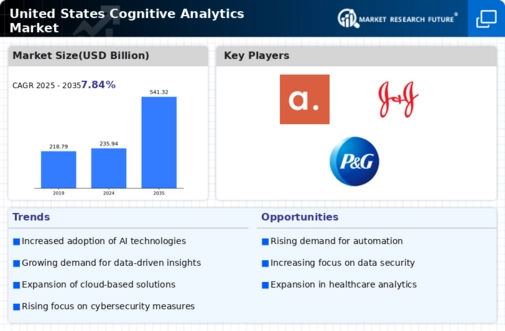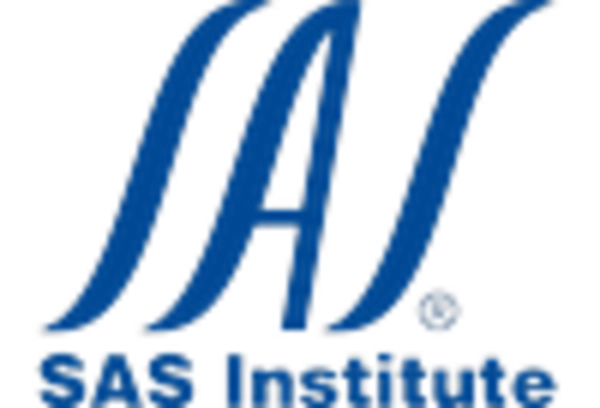The cognitive analytics market is currently characterized by a dynamic competitive landscape, driven by rapid advancements in artificial intelligence (AI) and increasing demand for data-driven decision-making. Major players such as IBM (US), Microsoft (US), and Oracle (US) are at the forefront, leveraging their technological prowess to enhance their offerings. IBM (US) focuses on integrating AI capabilities into its Watson platform, aiming to provide comprehensive analytics solutions that cater to various industries. Meanwhile, Microsoft (US) emphasizes its Azure cloud services, which facilitate cognitive analytics through scalable infrastructure and advanced machine learning tools. Oracle (US) is strategically positioning itself by enhancing its cloud applications with cognitive features, thereby appealing to enterprises seeking integrated solutions. Collectively, these strategies foster a competitive environment that prioritizes innovation and technological integration.
In terms of business tactics, companies are increasingly localizing their operations to better serve regional markets, optimizing supply chains to enhance efficiency. The market structure appears moderately fragmented, with a mix of established players and emerging startups. This fragmentation allows for diverse offerings, yet the influence of key players remains substantial, as they set industry standards and drive technological advancements.
In October 2025, IBM (US) announced a partnership with a leading healthcare provider to develop AI-driven analytics solutions aimed at improving patient outcomes. This collaboration underscores IBM's commitment to applying cognitive analytics in critical sectors, potentially revolutionizing healthcare delivery through data insights. The strategic importance of this partnership lies in its potential to enhance IBM's market share in the healthcare domain, where data-driven decisions are increasingly vital.
In September 2025, Microsoft (US) launched a new suite of cognitive services integrated into its Dynamics 365 platform, designed to enhance customer relationship management through predictive analytics. This move reflects Microsoft's strategy to embed cognitive capabilities across its product lines, thereby increasing customer engagement and retention. The significance of this launch is evident in its potential to attract businesses seeking advanced analytics tools to drive sales and marketing strategies.
In August 2025, Oracle (US) unveiled its latest cloud-based cognitive analytics solution, which incorporates machine learning algorithms to provide real-time insights for businesses. This development is crucial as it positions Oracle as a competitive force in the cloud analytics space, appealing to organizations looking for agile and responsive data solutions. The introduction of this technology may enhance Oracle's competitive edge, particularly among enterprises transitioning to cloud-based infrastructures.
As of November 2025, the cognitive analytics market is witnessing trends such as increased digitalization, a focus on sustainability, and deeper AI integration. Strategic alliances are becoming pivotal, as companies collaborate to enhance their technological capabilities and market reach. Looking ahead, competitive differentiation is likely to evolve, shifting from price-based competition to a focus on innovation, technology, and supply chain reliability. This transition suggests that companies will need to invest in cutting-edge technologies and strategic partnerships to maintain a competitive advantage.

















Leave a Comment